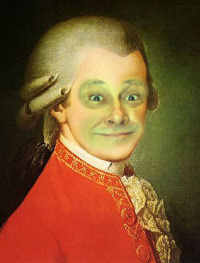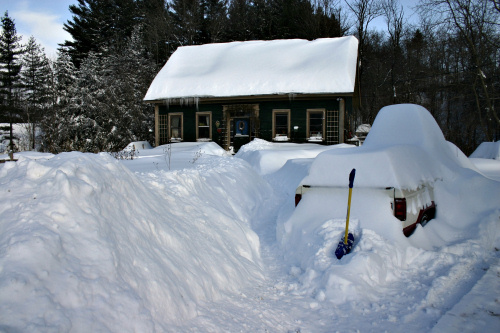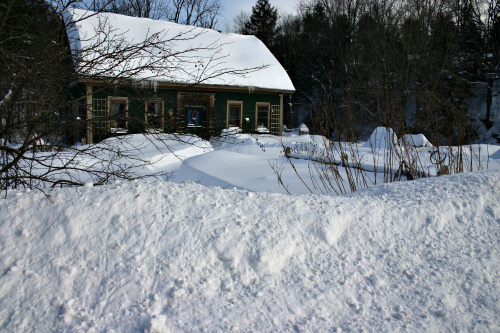A 365-Day Project
"We Are All Mozart"
A project to create
new works and change
the perception of the
music of our time.


 February 26, 2007
February 26, 2007 
The first thing you notice is the stark contrast. Bright whiteness is coming in the side windows, but the skylights above, usually filled with warm morning light, are almost black. The shortest day was two months ago, so you know when the alarm beeps that it's got to be morning. And then it shines through the mental fog -- it's been snowing all night, and that's caused the whiteness from the side and has made a thick, opaque blanket above, turning your morning upside-down.
And then it's time to face the outside, to push the door open against the drifted snow collected in delicate opposition, to shovel a starting path and, in a nod to one's aging back, to push not the shovel further but to pull instead the cord on the snow blower. The first such machine had burned itself up two years ago in a burst of recall-fueled flames and fire department guffaws; a begrudging replacement and accompanying refund removed some of the green guilt for owning one, and on this day its presence was welcome. In a few hours the path was cleared to car, barn, woodpile, and kindling bin (though not to the mailboxes).
But before pulling that snow blower cord, it's the silence that's unique and gripping, nearly claustrophobic. The idea of a snow blanket is visual, and it's thermal -- the house will now be warmer unexposed directly to below-zero temperatures -- and it's sonic. Nothing can be heard. One's own motion is absorbed by the snow cover, and when the train does pass through spewing a great fountain of white, its whistle is far away. Then the only sonic company is my tinnitus.
Oh, no, we don't get snow like those who live near the Great Lakes, but this fall -- at thirty-four inches -- was the largest single day's accumulation in our town's history. It felt like the past had come to visit.
Latest Tunes
It's been almost two weeks since the last commentary here, and much has happened, particularly family events, joys and stresses. Those who have been in touch know that, from a new grandchild to a blanket of snow, the days have been full. Four "We Are All Mozart" compositions were created during this stretch, and each has a story.
On February 15, a song was delivered to Nora Tombalakian. Last year she had pointed me to some of her work, and set me loose to create something under four minutes for voice and piano. Here's the thing. Nora's songs are tonal, expressive, mysterious and a bit world-musicky. And they can perhaps be described as art song. I don't like art song -- whether or not contemporary composers express an admiration of Schubert. That admiration I can neither share nor even understand. So toss me a symphonic commission and I'm a pig in sugar; writing for Nora would be difficult.
The text, as has been mentioned here before, had to date from before 1923 because of the absurd creation of and extensions to fictional rights to everything from words to your own genes (read all about it) that prohibits the use of texts up to ninety years old without facing permissions or prohibitions. The search led me to Armenian poet Zabel Khanjian Assatour and a mysterious love-death poem entitled "The Ideal". Translated and published in 1917, its multiple meanings were at once sighingly beautiful and deeply painful.
Aside from selecting an uncharacteristically functional tonality, I also allowed the text to sing itself in a simple shape while expanding and contracting in meters of four, four-and-a-half, five, five-and-a-half, six, and six-and-a-half that encouraged in it a timelessness and ambiguity, filled with slipping notes and melismas. In Schubertian terms, it is probably the single most beautiful piece I've ever written. You can hear The Ideal in a Midi demo with sampled cello in place of voice and sing it yourself with the score. Unfortunately, I've yet to hear back from Nora.
* * *
Two days later, and in keeping with the still-packed Valentine's Day snowfall, came the February section of Lunar Cascade in Serial Time. (A description of the overall project and the downloadable January section are at the end of the January 24 commentaries.) February will be the stillest of the series of twelve, with each of its own twelve modules being small, compact and repetitive, looping in sound and technique from one to the next. Inspired by the silence of the snow, I included significant quietude as the piece moves slowly and repetitively forward. The February score is here
* * *
A new ensemble, nameless at the time of the commission, asked for a new piece for viola, horn, cello and piano. Munging the names of some of the players, I started calling them "The Blaizing Calfe Bustlers" and set out to create something in that spirit -- and what better than a straightforward romp through rhythmic tonality? After writing The Ideal, I did get a wry note from composer Reena Esmail, who intimated that perhaps music could be better served than with tertian harmony. I wrote to her,
|
I have been thinking about this. Odd, you know ... it's only in the past decade that I've actually had commissions from people who wanted or implied a desire for traditional harmony. For the first time in most of my compositional life, I've actually had the opportunity to explore it through my own harmonic lens. It's really, really interesting -- and aside from choral writing for amateurs, the approach is new for me. (How old am I to be saying, "hey, look, chords!") |
And it's true. Though I've composed with traditional harmonies, they were largely an exercise in achieving a stylistic goal, but not close to the heart. After more than forty years, I finally begin to get it in the same intimate way that I get electroacoustics and get serialism and get the formel and get the algorithm. And, for now at least, it's rewarding.
Turn Around, Bustle & Blaze exploits minimalist chords'n'motion tendencies, and presents a langorous theme reminiscent of Mantra Canon from 1986, but more robust. It slowly builds into a rock rhythm, extracting itself in a unison blast and diving back to the simpler chords. A certain dissatisfaction is echoed by the horn, stopped for the first time, and the viola, pizzicato for the first time. In a larger composition (and who knows?) this would be the beginning of another development. Instead, the ensemble answers the posed question by ... stopping.
A pretty good Midi demo is available and you can download a score to follow along.
* * *
By yesterday it was time to turn away from tonality before my teeth hurt. A local writer, Nathan Freeman, is a study in the Vermont way. Not only is he a writer, but also a supporter of the arts, a guy who once sold insurance, a designer, an artist, and the successor in his family's upholstery business (some years ago, he created for us a beautiful American flag in the most unlikely fabrics). He produced and funded Manifest Poetry, a multi-day celebration of the arts, wrote a published book of poetry called The Offspring, and in early 2000 produced a series of videos by slam poet Shannon Williams.
Nate isn't a musician, but he wanted a personal piece. I had been the sound recorder and editor for the Shannon William series that was dear to Nate's heart (and never completed, leaving an archive of takes and edits), and during the production process had created several electroacoustic mixes entirely from Shannon's voice (to this day one of the most popular downloads from my website). And so this new piece seemed important to base on what had become known to Nate simply as "Mix 26".
The Offspring became "offering" and Shannon's poem "Born Again" was borne again to Nate through the piece, and hence the title, An Offering Borne Again. From Mix 26, the voices and voice-based instruments were extracted, re-formed into regular rhythms, and pitches melded to them. This raw material was worked over until it became rhythmically simpler, musically coherent and highly expressive. Upon receiving it, Nate wrote, "Not only did I enjoy what you produced, but I also feel real ownership, in a belly-understanding of the word. 'Feels good. Right here.'"
See if you agree. You can listen to a Midi demo that's got lots of energy and download the score.
Parochial Stuff
The glories of Vermont get extolled in these commentaries, but it's not all good -- and that's not just the weather. We have an arts council that's the very archetype of incompetence. Arts council are by and large made up of management mediocrities and dithering volunteers, so there's no news in such a comment. They're tolerated because nationwide the vast grey phalanx of failed artists figured out how to cash in with little talent and less skill into holding the purse-strings for an arts-terrified government, the snip off the sudden inspiration and to tidy up confrontation with a veneer of Walmartian smiley faces. But it's all the worse here in Vermont, where the bulk of its management is made up of retro downcountry exiles who bring little to the organization but bureaucratic finesse and taste for a paycheck higher than most of the artists they pretend to serve.
Back in the Kalvos & Damian days, we gave them the third of our coveted Golden Bruce Awards, writing:
|
The Vermont Arts Council is a parochial choice for a Golden Bruce, but we award it to them as archetypes of arts council incompetence everywhere. After a year of being mercifully shuttered, the VAC came back to hijack a National Symphony Orchestra commission project and brazenly do the preliminary screening. Aside from guaranteeing conservative results (Vermonty cows & maple syrup images), the VAC sent private submission materials back to the wrong people, even though self-addressed, stamped envelopes were provided. Materials were hardly touched, which makes the invasion of privacy even more absurd. Some say that the VAC and its kind provide a service by consolidating arts opportunities in one place. We say they should stop doing damage and shut their doors again as soon as possible. Thus, the third Golden Bruce is awarded to the Vermont Arts Council for cataclysmic incompetence. |
Yes, it's really a petty thing, but like flies on roadkill, they just won't go away. Seven years after the Golden Bruce, their cheerful smileyface stumbling continues. They have a website now -- not a good one, and one that violates the Section 508 Standards, but it's there if you don't have the good sense to avert your eyes. And certainly I should know better than to think about them, much less deal with them. But being the perennial optimist perennially on the economic edge, I clicked myself their way.
For our upcoming Portugal residency at Binaural Media, a little airfare assistance would relieve the economic pressure, and I'd been hunting for opportunities. Not being one to apply for grants -- perhaps a half-dozen in my lifetime -- I approached the Vermont Arts Council application with considerable hesitation and not a little shame over being hypocritical. But, to my surprise, they had actually put into play one of my persistent suggestions (twenty years' worth of persistent, since Daniel Hecht and I had headed an advisory group that helped lead to their year-long shutdown): a short-deadline funds opportunity (short meaning sixty days, but certainly better than the year it had been). At a $750 maximum, it just fit the need.
Ah, but the application fee is ten bucks, a fact that popped up after eleven pages of information had been filled out on a hopelessly formula-based online application. (What are my long-term career goals? Is this the high school guidance office?) By eleven pages, of course, I was suckered in. What to do, waste a day's work, or throw good money after potential bad? Throw I did. And then came the clincher. Here it is 2007, and the council wanted a physical copy of the application. And not only that, rather than actually provide for their paycheck an actual service between artist and jury, they wanted physical materials submitted as well.
Now jes' thinkathat, as Will Rogers would have said. Here's a nice handy website and an online form, but when it comes to the final application, it was to be printed and shoved into an envelope with materials I'd be re-downloading from my own website and putting onto shiny petroleum- and cyanide-based plastic disks to send their way via internal-combustion postal trucks. This scurrilous laziness was from representatives of our environmentally sensitive green state, no less!
I thought to send the form electronically, with links and an electronic signature. Here's a copy of a head-banging email exchange worthy of Brazil:
VAC: We need a signed copy of your application indicating that the information you have provided us is accurate.
Me: Can I send you a cover sheet with an electronic signature? The actual residency that I'm asking for travel support for was done electronically. Vermont's usually in the forefront. Howsabout this time? :)
VAC: Sorry no. We'll need a hard copy with signature.
Me: Ah, well, never mind. Keep the ten bucks.
VAC: Should I expect to receive your signed application in the mail or are you withdrawing your application?
Me: Neither. I am submitting it with an electronic signature page attached to this email, and all support materials as links within the body of the application. The application fee is paid.
VAC: Sorry, no can do. You must send us a hard copy and hard copies of support materials.
An astounding display of incompetence and ignorance, and a continuing embarrassment to Vermont -- or as they'd say on Only Fools and Horses, what a bunch of plonkers. (Hmm... since my application wasn't even accepted, do you suppose I get my ten bucks back?)
* * *
That's it for tonight, and too much parochial bizniz. Tomorrow I have some ideas about improvisation. Unfortunately, it looks like somebody's hit a pole up West Hill. The entire cable television and internet system is down, so this will get posted tomorrow. (Note at 8:30am: Still no service. The entire area remains down.)

Our house in snow. The truck was buried (yes, that's it on the right) and its bed was filled with snow -- and then some. Look at the house roof, and you can see the skylights as slight indentations under the three feet of snow. That's why it was dark.

Our mailboxes are under that oval highlight. Neither rain nor sleet maybe, but if the mailboxes aren't available, don't expect the post. It arrived the next day, when these were dug out.

How deep is it? Compare the fence just visible above the snow at the right with this photo of that fence just built back in July.